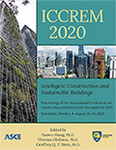International Conference on Construction and Real Estate Management 2020
An Optimization Model of Population Distribution from the Perspective of Sustainable Development
Publication: ICCREM 2020: Intelligent Construction and Sustainable Buildings
ABSTRACT
Rapid urbanization causes serious environmental problems and resources waste, therefore it is essential to plan for the population agglomeration and distribution for the government. This paper developed an optimization model for regional population distribution which includes three parts of rationality evaluation model, contribution degree analysis, and multi-objective programming model. This model provides theoretical support and quantitative technique for the selection of corresponding optimization strategies for sustainable region development.
Get full access to this article
View all available purchase options and get full access to this chapter.
ACKNOWLEDGMENTS
The authors would like to thank the Ministry of Education in Philosophy and Social Science (19YJCZH110), Guangdong Planning Office of Philosophy and Social Science (GD16YGL07), Department of Education of Guangdong Province (2016WTSCX094), Guangzhou Civic Bureau of Education (1201630536, 1201630545), National Natural Science Foundation (41701174) in China for supporting this project.
REFERENCES
Chen, Y. (2008). “A wave-spectrum analysis of urban population density: entropy, fractal, and spatial localization.” Discrete Dynamics in Nature and Society,3(6), 25-31. (in Chinese).
Chen, Y. (2010). “A new model of urban population density indicating latent fractal structure.” International Journal of Urban Sustainable Development,1(1-2), 89-110. (in Chinese).
Dai, S.G. (1996). “Strategies of Shanghai’s space exchange and population redistribution.” Urban Research, 3(4), 30-33. (in Chinese).
Gerald, M.B. (1977). “Urban population distribution planning.” Annals of the Association of American Geographers, 67(2), 239-245. (in Chinese).
Wang, D.L., Fang, C.L., Gao, B.Y., Huang, J.C. and Yang, Q.S. (2011). “Measurement and Spatio-temporal distribution of urbanization development quality of urban agglomeration in China.” Chinese Geographical Science, 21(6), 695-707. (in Chinese).
Wu, Y.B. (2010). “Study on urban spatial structure optimization in the process of Shanghai’s suburbanization.” Journal of Tongji University (Social Science Section), 21(4), 45-53. (in Chinese).
Yang, D.Y. (2008). “The research on Guangxi city system spatial structure based on fractural theory.”Commercial Research,3(7), 33-38. (in Chinese).
Yang, R., Xu, Q. and Long, H.L. (2016) “Spatial distribution characteristics and optimized reconstruction analysis of China’s rural settlements during the process of rapid urbanization.” Journal of Rural Studies, 47(64), 413-424. (in Chinese).
Zhou, Y.X. and Zhang, L. (2003). “China’s urban economic region in the open context.”Acta Geographica Sinica, 2(5), 15-18. (in Chinese).
Zheng, D. and Dai, E.F. (2012). “Environmental ethics and regional sustainable development.” Journal of Geographical Sciences, 22(1), 86-92. (in Chinese).
Information & Authors
Information
Published In
ICCREM 2020: Intelligent Construction and Sustainable Buildings
Pages: 304 - 313
Editors: Yaowu Wang, Ph.D., Harbin Institute of Technology, Thomas Olofsson, Ph.D., Luleå University of Technology, and Geoffrey Q. P. Shen, Ph.D., Hong Kong Polytechnic University
ISBN (Online): 978-0-7844-8323-7
Copyright
© 2020 American Society of Civil Engineers.
History
Published online: Oct 14, 2020
Published in print: Oct 14, 2020
Authors
Metrics & Citations
Metrics
Citations
Download citation
If you have the appropriate software installed, you can download article citation data to the citation manager of your choice. Simply select your manager software from the list below and click Download.
